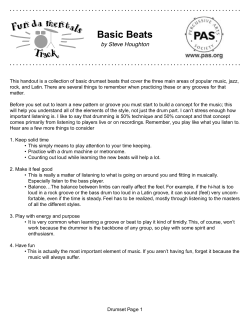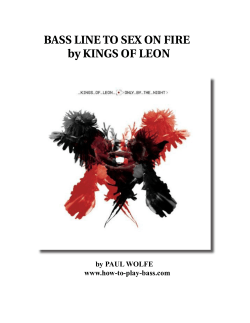
The Ten “Must-Have” Grooves for your Rhythm Section
The Ten “Must-Have” Grooves for your Rhythm Section Barb Catlin CASMEC Conference - 2/2013 1. Two-feel swing: Main focus: Pulse centered around half notes. Good for use on A sections of AABA form or for first part of tune to break up the 4 feels. DRUMS: • Hi-hat on 2 & 4 w/ ride in half note patterns. • Little to no comping on snare. BASS: • Copies pattern on ride cymbal. • Bass “walks” a few measures here & there-usually at end of phrases. PIANO/GUITAR: • comp in elongated figures. Be the harmonic “pad” – not too busy. GUITAR: • “Freddie Green” (four on the floor) works on slower to medium tempos Drums can do a hi-hat figure as variation: 1 2. Four-feel swing: Main focus: Quarter note groove! Bassist and drummer are “best-friends” with the quarter note! DRUMS: • Focus on quarter notes on ride. “Spang-a-lang” is secondary to groove! • Cross-stick on 4. • Variation: cross-stick on 4 - next measure toms on 4+ • Never comp with cross-stick. • Variation: Can free comp on open snare. • Always save 2 & 4 (open or cross-stick) to “drive” the band. Use sparingly. • No (or VERY light) feathering( “four on the floor”) on bass drum. • Change cymbals for color and phrase highlights. BASS: • Walks. Line up with ride cymbal. PIANO/GUITAR: • Piano/guitar comp with elongated, simple figures combined with shorter patterns. • Compers should use space, especially on faster tempos. • Always anticipate the chords; don’t get “behind” in the changes. • Trade off comping for soloists. Stay with soloist for duration – don’t change every chorus. GUITAR: • only use “Freddie Green” on appropriate tunes and tempos (like a Basie tune!), otherwise can get vertical, especially on fast tempos. • Piano and guitar CAN comp together-one using pads (simple and elongated rhythmic patterns) and one using sparse, rhythmic patterns. Play the quarter note game: Have the bassist look at the drummer’s ride cymbal where the stick hits; have the drummer look at the bassist’s pulling hand. Have the bassist play random quarter notes (or blues or rhythm changes) and vary the tempo widely and have the drummer follow where they place the quarter notes exactly using only quarter notes on the ride. Have them switch roles. Then have them close their eyes to do the same. Finally, go back to whatever tune you are working on – they will be tuned into the quarter note by now! 2 Listen: • “Kind of Blue” by Miles Davis with Jimmy Cobb (drums) & Paul Chambers (bass) or anything with Jimmy Cobb! • “Soul Station” by Hank Mobley with Art Blakey (drums) & Paul Chambers (bass) Watch: “Miles Davis & John Coltrane: So What” http://www.youtube.com/watch?v=V1hT2u1jwcs 3 3. Jazz Shuffle Main focus: 4 feel swing with triplets highlighted-still quarter notes! Strong backbeat feel on 2 & 4 DRUMS: • Communicate triplet feel with hi-hat or snare. • Mix up the shuffle pattern with straight ahead 4 feel –especially on solos. BASS: • Bass walks as in 4 – same as 4 feel swing. PIANO/GUITAR: • Piano/guitar comp to highlight triplets • Lay into repetitive patterns to groove Variation for drums: Ride cymbal with quarters/spang-a-lang, triplets on snare: Listen/watch: Youtube video: “Drums Steve Gadd Shuffle groove” http://www.youtube.com/watch?v=H4ABE9gcKao 4 4. Bossa Nova (medium tempo Brazilian groove) Main focus: Brazilian feel of light, acoustic guitar comping Think sixteenth notes on a shaker -Dance-like! DRUMS: • Ride or hi-hat pattern eighth notes • cross-stick on snare with Brazilian rhythm 2 bar pattern. • Kick drum: half note-emphasis on 1 & 3-Surdo drum BASS: • Bass centered around half-note pulse with kick drum • Accent beat 3. PIANO/GUITAR: • Piano comp using Bossa rhythm (cross-stick pattern) or longer duration patterns GUITAR: • Guitar comps cross-stick pattern lightly • Plucked chords is traditional Here’s another common Bossa 2 bar rhythm: 5 5. Samba (faster tempo Brazilian groove) Main focus: Emphasis on 1 & 3-especially 3! Light-not heavy -Dance-like! DRUMS: • Emphasis on 1 and 3-especially 3 • Snare and ride play samba pattern-start w/ unison then add • Light and low BASS: • Bass centered around half-note pulse w/ kick drum-beat 3! PIANO: • Piano comps within the same snare pattern (agogo) w/ drums • And/or elongated “pads” while guitar plays rhythmically GUITAR: • Guitar comps snare pattern (or long duration patterns) • Plucked and light chords PERCUSSION: Bossa & Samba: • Shakers and triangle, not congas or cowbell – light • Samba: Pandeiro, Tamborim, Cuica, Agogo • Look it up – DO NOT GUESS! Important Brazilian percussion roles: 6 (Samba continued) Good “starter” samba-unison in hands for drums: Have drummers play these with any two voices/percussion and piano/guitar comp same pattern: Ex.1 Ex. 2 Ex. 3 Ex. 4 7 More challenging patterns for drummers: 8 6. Ballad Main focus: longer durations & space Beautiful, expressive sounds; not boring! Round/horizontal, not vertical DRUMS: • Use variety of patterns with brushes, mallets etc. Use cymbals for color and move around kit. • Side to side, lateral motions, leave one brush on head at all times • Use articulation on snare to create rhythmic information for the band, not only the hi-hat. • Make hi-hat “fluffy” & open, not vertical/clicky • Need a coated head (or etched - Evans J1) BASS: • Long sustained notes in bass with vibrato • Joel DiBartolo said, “Love every note. Make every note as beautiful as possible.” PIANO/GUITAR: • Piano/guitar comps with simple sustained figures. BALLAD TIPS: • ALWAYS morph gently into double time and back-it’s still a ballad. • Never go directly from a ballad/brushes to straight 4 – ease into 2 feel, then 4 feel. • Always feel free to STAY in ballad – you don’t always have to go to double time! Let your set breathe with space, color, and beauty. • Excitement comes in many forms WATCH: “Jeff Hamilton Brush stroke technique and demo song” http://www.youtube.com/watch?v=MMlbw0VbVuc Watch: Peter Erskine Brush Lessons #1-6: Developing a Legato Sound http://www.youtube.com/watch?v=zeMhe0CT-wM Watch: Vic Firth’s “Drumset 101” with Steve Houghton for lots of tips on all styles! http://www.vicfirth.com/education/ 9 7. Jazz Waltz Main focus: Swing in 3! Emphasis on two main rhythms: DRUMS: • Hi-hat on 2 (or 3) BASS: • Bass patterns between dotted half, dotted quarter, and walking PIANO/GUITAR: • Piano/guitar feels comping in one – longer durations Drum Ex. 1 Drum Ex. 2: Listen: Miles Davis “Someday My Prince will Come” Bass pick-up info: Underwood Fishman Full Circle ($225-250) Wilson ESP (more $$$) 10 8. Cha-Cha (Cuban medium tempo groove) Main focus: Cuban - medium tempo based on Danzon Emphasis on all four quarters (cowbell) DRUMS: • Imitate cowbell with cross-stick on all quarters BASS: Variation of Tumbao pattern-using V7 chord (even over ii7) PIANO/GUITAR: • Play “cha-cha clave” (Danzon 2-3 pattern) PERCUSSION: congas, timbales, bongos, guiro, cha-cha bell Another piano cha-cha pattern: LISTEN: “Oye Como Va” Tito Puente, “Morning” Clare Fischer 11 9. Mambo (Cuban up tempo groove) Main focus: Emphasis on beat 4, not 1! Piano plays montuno Son clave (2-3) or (3-2) depends on melody DRUMS: • kick drum does a tumbao related pattern • alternate toms BASS: Traditional bass tumbao. Reset on 1 if needed! PIANO:Piano comps a montuno (arpeggiate chords 2 octaves apart) GUITAR: Guitar comps clave Mambo 2-3 son clave: Listen: “Mambo #5” Perez Prado, “Manteca” Dizzy Gillespie 12 10. Songo (Cuban upbeat groove) Main focus: Contains many rhythmic styles & variations DRUMS: Kick drum w/ bass on tumbao BASS: Bass tumbao w/ variation PIANO: montuno patterns GUITAR: clave patterns Books: • • • • • • • • • “Salsa Guidebook for Piano & Ensemble” by Rebeca Mauleon (Sher Music) “Latin Percussion for Gringos” by Dom Moio (website) or any of his books “Rhythm Section Workshop for Jazz Directors” by Shelly Berg, Lou Fischer, Fred Hamilton, Steve Houghton (Alfred) “Jazz Piano” Mark Levine “Voicings for Jazz Keyboard” Frank Mantooth “Serious Electric Bass” by Joel DiBartolo “Rufus Reid Bass Lines” Jamey Aebersold Transcriptions of Play-a-longs “Ray Brown’s Bass Method” (Hal Leonard) “Joe Pass Guitar Method” or anything by Pat Martino or Joe Diorio 13 Barb Catlin Cell: 602.432.2678 Email: barbcatlin@gmail.com Bio: Originally from the San Francisco Bay Area, Barb Catlin has become one of the Southwest’s leading jazz educators and pianists. Her extensive touring, cruise ship, and show playing include work with top entertainers such as Smokey Robinson, Michael Crawford and many others. Barb’s performances have gained her local and national recognition; her trio was voted as an “Arizona Favorite” by KJZZ’s Listener’s Poll and Barb was named by Downbeat Magazine as a “Player to Catch.” Barb majored in music education on woodwinds at California State University at Fresno and completed her Master’s in Music Education with an emphasis in Jazz Studies on piano from Arizona State University. Barb recently returned to her home state of California, where she is currently teaching at CSUN and Pomona College. During her 18 years in Arizona, Barb was the Director of Jazz Studies at Mesa Community College in the Phoenix-metro area and had eight highly successful years as Musical Director of the award-winning youth honor jazz program, The Young Sounds of Arizona. Her students have been featured in the Grammy Jazz Bands, Wynton Marsalis’ All-American Jazz Ensemble, the Dave Brubeck Institute, and the Mancini Institute. Her enthusiasm for playing, “real-life” approach to education, and expertise in the rhythm section has made Barb a popular clinician and adjudicator at the high school and college levels. Recently Barb was a featured adjudicator and soloist at Fred Sturm's Lawrence Jazz Festival, Kris Berg's Collin College Jazz Festival and director of the Arizona All-State Clinic Jazz Band and the Central California Honor Jazz Band. In April 2011, Jazz in Arizona awarded Barb their “Lifetime Achievement Award” for her outstanding contribution to jazz education in the state of Arizona. Many thanks to my good friend, Dom Moio, who helped with the drum parts. Dom is the drum professor at Arizona State University. He is a well-‐respected educator and performer. Please check out his books: Latin Percussion in Perspective Bebop Phrasing for Drums Latin Percussion for Gringos The Jury’s Out The Language of Jazz 30 Duets for Snare Drum 30 Duets for Sightreading 50 Ways to Syncopation Just Duet w/ Steve Gadd Deep Grooves II w/ Steve Gadd Deep Grooves Available Mel Bay & website Available Mel Bay & website Available on website Available on website Available on website Available on website Available on website Available on website Available on website Available on website Available on website www.dommoio.com 14
© Copyright 2025





















